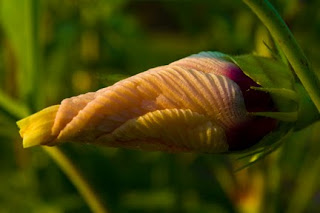Okra could perhaps be described as an "acquired" taste. Being a "northerner" I was never exposed to okra except as I searched for those funny looking little stars with round seeds in the middle, in Campbell's Chicken Gumbo soup.
So, when I first tasted (and, more importantly, felt) okra, I was not impressed. More to the point, sadly, I was influenced by the ...well..."sliminess"...or putting it more politely, the mucilagenous qualities of this odd vegetable. MM, on the other hand, having had some southern exposure as a child, was a devotee of okra. When there are just two in the household, though...cooking independently according to our likes and dislikes, is...difficult. Something's gotta give. So, I bravely kept trying to find a way to cook okra so I could eat it. The final assault on it was to roll the little slices in egg and then cornmeal and lightly fry it (and I am not a fried foods lover...) , and that's done the trick. Boiling it is to kill it. I'm told that if you add a little lemon juice, or some vinegar or tomatoes or some other acidic compound, the mucilagenous qualities disappear. I can't vouch for that. But from a photographic standpoint, okra is a lovely subject! I spent a little time in the okra patch last evening. This is our best year ever for growing okra, probably because the variety --Beck's Big Buck okra is fabulous, and the weather has been ultra-hot which okra loves.
A brief bit of history of okra, first....It's often called Lady Fingers and is a tropical member of the mallow family.
There are many varying opinions as to where okra was born. Some say Africa, specifically Ethiopia, with its being transported to America through the slave trade. And it's known to have been cultivated in Egypt around the 12th century B. C. It grows best in high temperatures..hence, its being labeled a "southern" vegetable. It also appears in Pakistan, Syria, Greece, Iran, Jordan, Lebanon, Turkey, and the eastern Mediterranean.
Nutritionally, okra is a good source of protein, niacin, phosphorus, iron, potassium, zinc and magnesium. It's a good source of folate and viamin K, with good amounts of vitamin A, C, B6, thiamin, manganese and calcium.
An odd bit of history: during World War II, the shortage of coffee beans resulted in okra seeds being substituted for coffee. (Wonder if the "coffee" was mucilagenous??!!
So, here is the photographic ode to okra...
This is the flower--slightly different color--of Beck's Big Buck okra
different from the Clemson Spineless
with its creamy yellow flower
The bees love okra! Lots of willing pollinators!
The pods are picked when they are still tender and not fibrous. A little experimentation will tell when they are ready and haven't gone too far...
The colors can vary...red to green. There is an all-red okra...
They're even lovely as the leaves end their cycle
An annual plant, they are almost done for the year.













Mmmm, okra. As a fellow northerner who never ate okra until I moved to WV, I'm in the camp who immediately loved it. I enjoy the stewed okra-tomato-corn combo, and am really looking forward to opening a jar of pickled okra. My least favorite way to eat it is fried!
ReplyDeleteElora -- I do think okra is a beautiful plant. I used to make a bourbon street chowder with okra and really liked it. I lost the recipe long ago and have not had anything with okra in since. Unfortunately I don't miss it. -- barbara
ReplyDeleteBeautiful photos! I grew up eating okra (boiled) and have always liked it. In fact, when I blanch it to put in the freezer for soups and gumbos, I always end up eating quite a few straight from the hot water bath -- no salt, no butter, no nothing. I just flat out like the taste. And the mucilaginous (slimy) quality simply doesn't bother me. But then I also adore raw oysters.
ReplyDelete